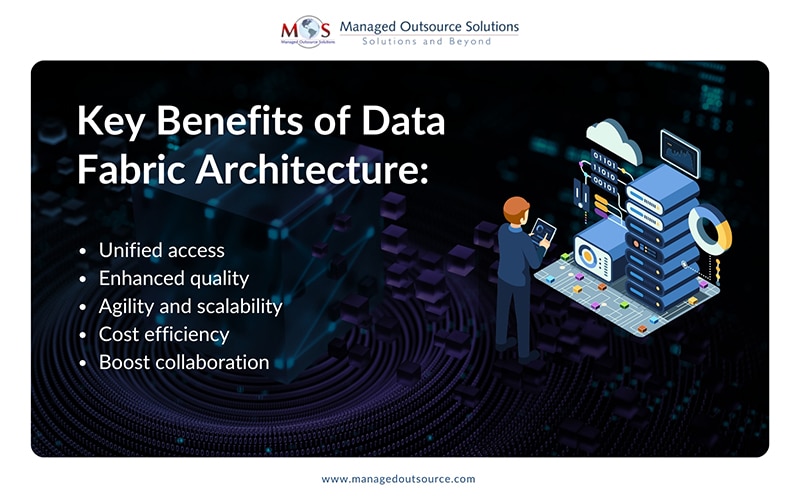In today’s information age, companies find themselves grappling with a range of obstacles, from siloed information to overwhelmed systems. As they race to derive trustworthy business insights for critical decision-making, a new organizational system has emerged to help streamline this process. Known as data fabric architecture, it acts as a bridge between the business requirements of companies and their distributed information repositories.
While it is gaining traction as emerging technology, many companies remain in the early stages of implementation. Businesses can seek the expertise of data processing services to fully leverage this solution, enhance evidence-based decision making, and drive financial growth.
What is Data Fabric?
Data fabric refers to a centrally governed framework that seamlessly connects and manages information pipelines and services in real-time. It is an innovative business intelligence (BI) solution that collects, cleans, integrates, and secures information from disparate data environments. It utilizes active metadata assets, semantics, knowledge graph, and machine learning to uncover patterns and find relationships across systems.
Traditional BI models limit companies as they cannot manage the vast volume of information generated at enormous pace. These models often struggle to integrate and analyze data from various sources such as social media, customer, and transactional databases. It highlighted the growing need for flexible, agile, and augmented business management solutions.
Data fabric addresses business challenges by using automation to simplify complex data infrastructure without moving it from source systems. It empowers non-technical users to access and analyze information, helping businesses break down silos, optimize workflows, and enhance decision-making. As a dynamic framework, it offers scalability and flexibility, and can be customized according to an organization’s specific business priorities and needs.
What is Data Fabric Architecture?
Data fabric architecture or framework is an advanced, end-to-end management framework designed to create a unified and holistic view of an organization’s information ecosystem. It is a virtual data layer built on the principles of service-oriented architecture (SOA), a software development model. By integrating information from hybrid, multi-cloud environments and different formats into a centralized location, it fosters data democratization.
The architecture typically consists of multiple layers, including ingestion, integration, storage, processing, and analytics, all interconnected through a central control plane. Among the myriad of characteristics, one key feature that stands out is the ability to preserve business logic and application context directly from the data. This capability eliminates the need to recreate the business context every time information is integrated from disparate environments, ensuring that the underlying processes, rules, and insights remain intact.
By maintaining this continuity, enterprises can enhance accessibility, optimize operational efficiency, and streamline administrative tasks, enabling agile market adaptation strategies. It also provides cost optimization by substantially reducing the time, resources, and errors associated with recreating lost context during the integration process.
Other characteristics of data fabric framework include:
- Unified and real-time access
- Information integration and orchestration
- Automation
- Interoperability
- Scalability and flexibility
- Decentralized architecture
- Governance and security
- Metadata management
- Self-service for non-technical users
Key Components
Here are the key components of data fabric framework that work together to provide a seamless, integrated layer that connects, manages, and processes information across distributed ecosystem:
- Integration: It integrates and unifies data from various sources, whether hosted on-premises or in the cloud. By enabling seamless ingestion, extraction, transformation, and loading (ETL) processes, it ensures availability, interoperability and consistency across systems.
- Governance: It ensures that information is managed securely, with consistent quality, accessibility, and compliance. By providing a framework for controlling access, privacy, and security, it ensures transparency and accountability in how data is used and processed.
- Orchestration: It manages the flow and processing of information across multiple systems and platforms, automating integration, transformation, and coordination to facilitate smooth operations and reduce the risk of bottlenecks.
- Virtualization: It is the process of providing a unified view of information without physically moving or replicating it. It uses virtualization techniques to create a virtual layer that enable real-time access across multiple systems, simplifying consumption while reducing storage costs.
- Data management: This process facilitates the storage and management of accurate, clean, and reliable variety of dataset types. It involves profiling, cleansing, validation, and deduplication to maintain high data quality, preventing errors that could damage analysis and decision-making.
- Modeling and semantic layering: They are essential steps in business analytics to gain insights and derive relationships between datasets by creating a common language across different systems. It applies analytics and machine learning to build a model and semantic layer for the content.
- Data Cataloging and Metadata Management: A robust catalog is capable of identifying, collecting, and analyzing all forms of metadata. The application of advanced techniques and automation of metadata enables analysts to uncover trends, eliminate bottlenecks, and produce strategic insights for better decision making.
- Knowledge graph: It is a network composed of three main entities known as nodes, edges, and labels, and interrelationships. It serves as a critical layer that links diverse data sources, providing a semantic layer of meaning and context to make it usable for querying, analytics, and decision-making.
- Real-time analytics: A real-time analytics system is designed to process information as it arrives, enabling continuous processing with minimal latency. This ensures immediate analysis and actionable results, helping companies adjust their strategies in real time based on the latest insights and forecast trends or behaviors.
- Self-service access: Self-service access allows users to independently retrieve, explore, and analyze information without relying on IT support. It allows non-technical users to explore, analyze, and derive insights without needing in-depth technical expertise.
You might also like: How Data Processing Services Optimize Business Operations
Key Advantages
Here are the key benefits that make data fabric framework a powerful business management solution:
- Unified access: Integrates data from various sources such as on-premises, cloud and edge into a single, unified platform for seamless access and visibility across the organization.
- Enhanced quality: Facilitates automated cleansing, transformation, and standardization of information while minimizing errors, thus improving the overall quality and reliability of data.
- Agility and scalability: Easily scales to accommodate increasing data volumes and supports a wide range of types, structures, and sources without sacrificing performance.
- Cost efficiency: Streamlines data management processes and reduces overhead by automating tasks such as integration, governance, and monitoring, to optimize resource allocation.
- Boost collaboration: Enhances cross-departmental collaboration and productivity by providing direct access to a consistent data layer that all teams can access and work with effectively.
Real-World Applications
Companies can leverage data fabric framework to streamline management processes, boost efficiency, and enhance decision-making, regardless of their size, industry, or operational needs.
The examples given below demonstrate practical applications in various scenarios:
- Customer Experience – Business data fabric solutions employ automation, which allows for the categorization and aggregation of customer information at various touch points to provide personalized recommendations.
- Manufacturing – Integrates information from suppliers, logistics, and inventory management systems to optimize the supply chain, monitor supplier performance, and demand forecasting.
- Financial services – Combining valuable information from various financial systems help financial services providers to improve risk assessment, fraud detection, and compliance to protect confidential financial information.
- Healthcare – By centralizing patient information from sources such as EHR, labs, and imaging, healthcare providers gain a comprehensive view of patient conditions, leading to improved diagnosis, treatment plans, and outcomes.
Why Outsource?
As the information landscape continues to evolve, companies can partner with a reliable outsourcing company specializing in data services to leverage data fabric architecture and drive long-term results. Businesses operating across numerous industries can access advanced technologies, focus on core competencies, and streamline operations without internal investments. By outsourcing various aspects of data management, companies can achieve higher quality outcomes, mitigate financial risk, and stay competitive.





